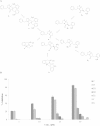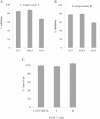Diversity-oriented synthesis and activity evaluation of substituted bicyclic lactams as anti-malarial against Plasmodium falciparum
- PMID: 25431142
- PMCID: PMC4289231
- DOI: 10.1186/1475-2875-13-467
Diversity-oriented synthesis and activity evaluation of substituted bicyclic lactams as anti-malarial against Plasmodium falciparum
Abstract
Background: Malaria remains the world's most important devastating parasitic disease. Of the five species of Plasmodium known to infect and cause human malaria, Plasmodium falciparum is the most virulent and responsible for majority of the deaths caused by this disease. Mainstream drug therapy targets the asexual blood stage of the malaria parasite, as the disease symptoms are mainly associated with this stage. The prevalence of malaria parasite strains resistance to existing anti-malarial drugs has made the control of malaria even more challenging and hence the development of a new class of drugs is inevitable.
Methods: Screening against different drug resistant and sensitive strains of P. falciparum was performed for few bicyclic lactam-based motifs, exhibiting a broad spectrum of activity with low toxicity generated via a focussed library obtained from diversity oriented synthesis (DOS). The synthesis and screening was followed by an in vitro assessment of the possible cytotoxic effect of this class of compounds on malaria parasite.
Results: The central scaffold a chiral bicyclic lactam (A) and (A') which were synthesized from (R)-phenylalaninol, levulinic acid and 3-(2-nitrophenyl) levulinic acid respectively. The DOS library was generated from A and from A', by either direct substitution with o-nitrobenzylbromide at the carbon α- to the amide functionality or by conversion to fused pyrroloquinolines. Upon screening this diverse library for their anti-malarial activity, a dinitro/diamine substituted bicyclic lactam was found to demonstrate exceptional activity of >85% inhibition at 50 μM concentration across different strains of P. falciparum with no toxicity against mammalian cells. Also, loss of mitochondrial membrane potential, mitochondrial functionality and apoptosis was observed in parasite treated with diamine-substituted bicyclic lactams.
Conclusions: This study unveils a DOS-mediated exploration of small molecules with novel structural motifs that culminates in identifying a potential lead molecule against malaria. In vitro investigations further reveal their cytocidal effect on malaria parasite growth. It is not the first time that DOS has been used as a strategy to identify therapeutic leads against malaria, but this study establishes the direct implications of DOS in scouting novel motifs with anti-malarial activity.
Figures




Similar articles
-
Design, synthesis and biological evaluation of novel bicyclic beta-lactams as potential antimalarials.Bioorg Med Chem Lett. 2005 Mar 1;15(5):1371-3. doi: 10.1016/j.bmcl.2005.01.011. Bioorg Med Chem Lett. 2005. PMID: 15713389
-
Exploiting a basic chemosensitizing pharmacophore hypothesis. Part 1: synthesis and biological evaluation of novel arylbromide and bicyclic chemosensitizers against drug-resistant malaria parasites.Bioorg Med Chem Lett. 2005 Jun 15;15(12):3024-8. doi: 10.1016/j.bmcl.2005.04.033. Bioorg Med Chem Lett. 2005. PMID: 15908208
-
Anti-malarial effect of semi-synthetic drug amitozyn.Malar J. 2015 Oct 29;14:425. doi: 10.1186/s12936-015-0952-4. Malar J. 2015. PMID: 26515752 Free PMC article.
-
Hits, leads and drugs against malaria through diversity-oriented synthesis.Future Med Chem. 2012 Dec;4(18):2279-94. doi: 10.4155/fmc.12.178. Future Med Chem. 2012. PMID: 23234551 Review.
-
Molecular Targets for Malarial Chemotherapy: A Review.Curr Top Med Chem. 2019;19(10):861-873. doi: 10.2174/1568026619666190603080000. Curr Top Med Chem. 2019. PMID: 31161990 Review.
Cited by
-
Natural Product Inspired Novel Indole based Chiral Scaffold Kills Human Malaria Parasites via Ionic Imbalance Mediated Cell Death.Sci Rep. 2019 Nov 28;9(1):17785. doi: 10.1038/s41598-019-54339-z. Sci Rep. 2019. PMID: 31780808 Free PMC article.
-
Integrative natural medicine inspired graphene nanovehicle-benzoxazine derivatives as potent therapy for cancer.Mol Cell Biochem. 2019 Apr;454(1-2):123-138. doi: 10.1007/s11010-018-3458-x. Epub 2018 Nov 3. Mol Cell Biochem. 2019. PMID: 30390174
References
-
- Prapansilp P, Medana I, Mai NT, Day NP, Phu NH, Yeo TW, Hien TT, White NJ, Anstey NM, Turner GD. A clinicopathological correlation of the expression of the angiopoietin-Tie-2 receptor pathway in the brain of adults with Plasmodium falciparum malaria. Malar J. 2013;12:50. doi: 10.1186/1475-2875-12-50. - DOI - PMC - PubMed
-
- WHO . World Malaria Report. Geneva: World Health Organization; 2013.
-
- Ballou WR, Kester KE, Stoute JA, Heppner DG. Malaria vaccines: triumphs or tribulations? Parassitologia. 1999;41:403–408. - PubMed
-
- Broccolo F, Cainelli G, Caltabiano G, Cocuzza CE, Fortuna CG, Galletti P, Giacomini D, Musumarra G, Musumeci R, Quintavalla A. Design, synthesis, and biological evaluation of 4-Alkyliden-beta Lactams: new products with promising antibiotic activity against resistant bacteria. J Med Chem. 2006;49:2804–2811. doi: 10.1021/jm0580510. - DOI - PubMed
Publication types
MeSH terms
Substances
LinkOut - more resources
Full Text Sources
Other Literature Sources

